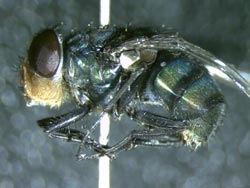Forensic Biologist Discovers New Fly Species in Indiana

This new fly species, Chrysomya Megacephala, is not native to Indiana but was found last fall in Indianapolis. Its discovery could impact forensic investigations.<br>
The local discovery of a species of fly not native to the Midwest could have significant implications on forensic investigations involving decomposing remains, according to a forensic biology researcher at Indiana University-Purdue University Indianapolis (IUPUI).
Christine Picard, Ph.D., assistant professor of biology in the School of Science at IUPUI, discovered the fly, Chrysomya megacephala Fabricius (C. megacephala), during a routine collection of fly samples in late September 2012. Until now, entomologists had never documented the fly farther north than New Mexico.
“Although I only found a single fly of this species, this is an important event in the area of forensics,” said Picard, also a faculty member in the Forensic and Investigative Sciences program at IUPUI. “Because this fly is not typically found here, we don’t know how it develops here, how to use that data or how it could affect the precision and accuracy of forensic investigations.”
The growth and development of flies play an important role for scientists looking to learn how long a human or other animal has been dead. When a new species is introduced, scientists or investigators may be at a disadvantage because of the little data that exists locally on that species.
C. megacephala breeds in the decomposing flesh of animals or discarded organic materials and has the potential to carry disease. Its existence could negatively impact the native species of flies as well, changing the dynamics of this highly specialized ecosystem.
“This discovery tells us as researchers that there is a new fly we have to consider, especially when we’re processing casework samples.” Picard said.
The fly specimen currently is stored at the Purdue University Entomological Collection, and it is the only one of its kind in its vast inventory. Picard’s discovery will be published in the July edition of the Proceedings of the Entomological Society of Washington journal.
This particular fly, native to Asia and Africa, first was documented in 1988 in the United States. Until now, it had been contained to the southern states, where the warmer climate allows it to grow and breed. The mild winter and long, drought-stricken summer of 2012 in Indiana likely contributed to the fly moving this far north, Picard said.
As average temperatures continue to increase, Picard predicts this will not be the last time Indiana sees this fly.
“This fly has the potential to become a dominant fly species in this area,” Picard said. “The changing climate conditions show us that we should never really stop collecting samples. We will be on the lookout this summer for more of this particular fly.”
Media Contact
More Information:
http://www.iupiu.eduAll latest news from the category: Ecology, The Environment and Conservation
This complex theme deals primarily with interactions between organisms and the environmental factors that impact them, but to a greater extent between individual inanimate environmental factors.
innovations-report offers informative reports and articles on topics such as climate protection, landscape conservation, ecological systems, wildlife and nature parks and ecosystem efficiency and balance.
Newest articles

Silicon Carbide Innovation Alliance to drive industrial-scale semiconductor work
Known for its ability to withstand extreme environments and high voltages, silicon carbide (SiC) is a semiconducting material made up of silicon and carbon atoms arranged into crystals that is…

New SPECT/CT technique shows impressive biomarker identification
…offers increased access for prostate cancer patients. A novel SPECT/CT acquisition method can accurately detect radiopharmaceutical biodistribution in a convenient manner for prostate cancer patients, opening the door for more…

How 3D printers can give robots a soft touch
Soft skin coverings and touch sensors have emerged as a promising feature for robots that are both safer and more intuitive for human interaction, but they are expensive and difficult…





















